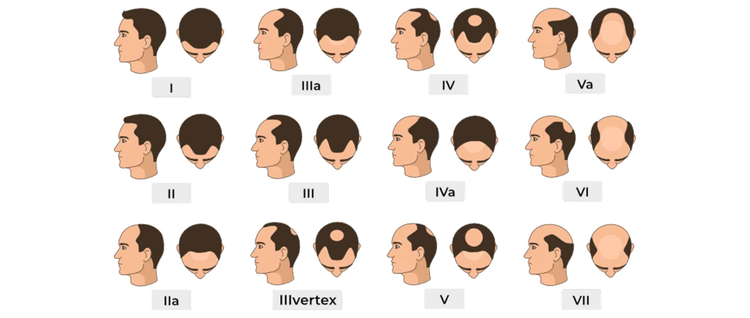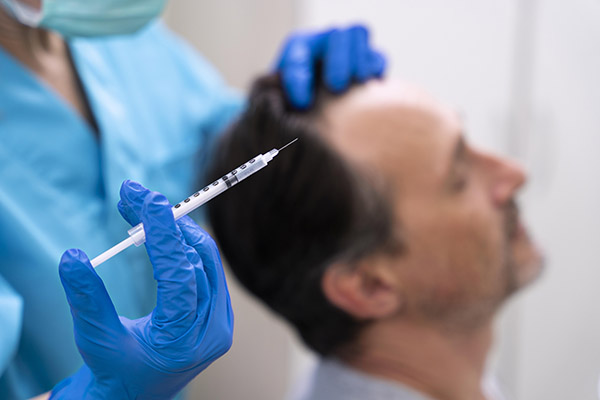Male Pattern Baldness (Androgenic Alopecia)
Hair loss is a common concern that affects a significant number of men worldwide.Understanding the causes, progression, and available treatments for hair loss is essential for managing this condition effectively.
What is male pattern baldness?
Male pattern baldness, also known as androgenic alopecia. It causes hair to thin or fall out on the scalp, and the hair doesn't grow back. Other signs include a receding hairline and overall thinning hair.
Male pattern baldness progresses through seven stages on the Hamilton-Norwood scale:
- Stage 1: Little or no hair loss or recession of the hairline.
- Stage 2: Slight hair loss near the temples, between the ears and forehead.
- Stage 3: Noticeable deep recession at the temples, with a hairline shaped like an "M" or "U".
- Stage 4: Deep hairline recession, with noticeable hair loss at the crown.
- Stage 5: The hairline recession connects with the bald spot on the crown.
- Stage 6: Hair between the temples and crown becomes thinner or disappears.
- Stage 7: No hair on the top of the head, with only a thin band of hair around the sides.

Symptoms of Male Pattern Baldness
Symptoms of male pattern baldness include:
- Thinning or loss of hair on the crown of your head.
- Thinning or loss of hair near your temples.
- A receding hairline.
Male pattern baldness is not painful. Many people notice the early stages in their 30s, though it can start as early as the late teenage years or early 20s.
Hair loss on the crown typically appears in a circular shape, while a receding hairline often forms an "M" shape.
What Causes Male Pattern Baldness?
Several factors contribute to male pattern baldness:
- Genetic Factors :
- Male pattern baldness is largely hereditary. Either Maternal or paternal or both can cause hair loss, later may lead to baldness also..
- The condition is linked to the androgen receptor gene [AR] on X chromosome which affects hair follicles’ sensitivity to hormones. - Hormonal Changes :
-Androgens, particularly dihydrotestosterone (DHT), play a significant role in hair loss.
-DHT is a derivative of Testosterone due to the enzymatic reaction.5 -alpha reductase type-2 enzyme.
-DHT binds to hair follicles, causing miniaturization of hair follicles.
- Medical Conditions :
-Conditions such as thyroid disorders, iron deficiency anemia, diabetes and low protein diet and autoimmune diseases like alopecia areata can cause hair loss.
-Crash diets and pure vegetarian diets.
-Recent past h/o illness, like fevers, and surgical h/o.
-Severe anxiety and depression & stress
-Cicatricial alopecia’s like LPP, pseudopelade, Dissecting folliculitis.
-Vitamin deficiencies like Vit D and Vit B12.
-Drugs -
1. Certain medications, including those used for cancer, arthritis, depression, heart problems, and high blood pressure, can cause hair loss as a side effect.
2. Chemotherapy and radiation therapy are well-known for causing hair loss.
What Causes Male Pattern Baldness?
Risk factors
A number of factors can increase your risk of hair loss, including:
- A family history of balding on your mother's or father's side
- Age
- Significant weight loss
- Certain medical conditions, such as diabetes and lupus
- Stress
- Poor nutrition
Tests for Diagnosing Male Pattern Baldness
To diagnose male pattern baldness, your healthcare provider may:
- Use a densitometer, a special tool that measures the thickness of your hair follicles.
If your healthcare provider suspects your hair loss may not be related to male pattern baldness, they may conduct additional tests, such as:
- Examining your scalp for signs of infection.
- Taking a hair sample and sending it to a lab for analysis.
- Performing a scalp biopsy to check for skin conditions.
- Conducting blood tests to rule out other causes of hair loss.
Medications and Treatments for Male Pattern Baldness
Treatment options for male pattern baldness include:
- Medications:
- Minoxidil (Rogaine®): An over-the-counter treatment applied to the scalp. It's often the first choice for treatment. Side effects may include headache, scalp irritation, and unusual hair growth.
- Finasteride (Propecia®): A prescription oral medication that helps treat male pattern baldness. Side effects may include allergic reactions, testicular pain, and erectile dysfunction.
- Dutasteride is also a drug used to control hair fall, which decreases the DHT by inhibiting the 1 and 2- 5 alpha reductase enzyme.
- Certain drugs like Corticosteroids are used for autoimmune conditions affecting scalp hair loss.
- Antifungal drugs for fungal infections, Antibiotics for bacterial infections
- Hair Transplant: A procedure where a healthcare provider moves skin grafts with healthy hair from one part of your body to areas with thinning or no hair. Side effects may include scalp pain, irritation, scarring, dizziness, nausea, and vomiting.
- Platelet-Rich Plasma (PRP): Injecting platelets from your own blood into the scalp to promote hair growth.
- GFC-Growth factor concentrate. Along with platelets , high concentrate growth factor preparation is injected into the scalp, which is giving the best result for hair growth.
- Styling Techniques: You can use specific hairstyles, wigs, or hair weaves to conceal baldness.
How to Help Prevent Male Pattern Baldness
While it may not be possible to prevent all types of hair loss, certain strategies can help reduce the risk:
- Healthy Diet: Ensuring adequate intake of vitamins and minerals that support hair health, such as iron, zinc, and vitamin D.
- Avoiding Hairstyles that Pull on Hair: Reducing the use of tight hairstyles like ponytails or braids that can cause traction alopecia.
- Limiting Heat and Chemical Treatments: Minimizing the use of hair dryers, straighteners, and chemical treatments that can damage hair.
- Regular Scalp Care: Keeping the scalp clean and healthy to prevent infections that can cause hair loss.
- Early consultation with specialists in cases of increased hair fall.
- In cases of genetic hair loss also early intervention is needed.
- Sometimes people need to change their life style along with personal habits.
Care at Radiance :
Our team of experts can help you with your hair loss-related health concerns
Our Doctors












